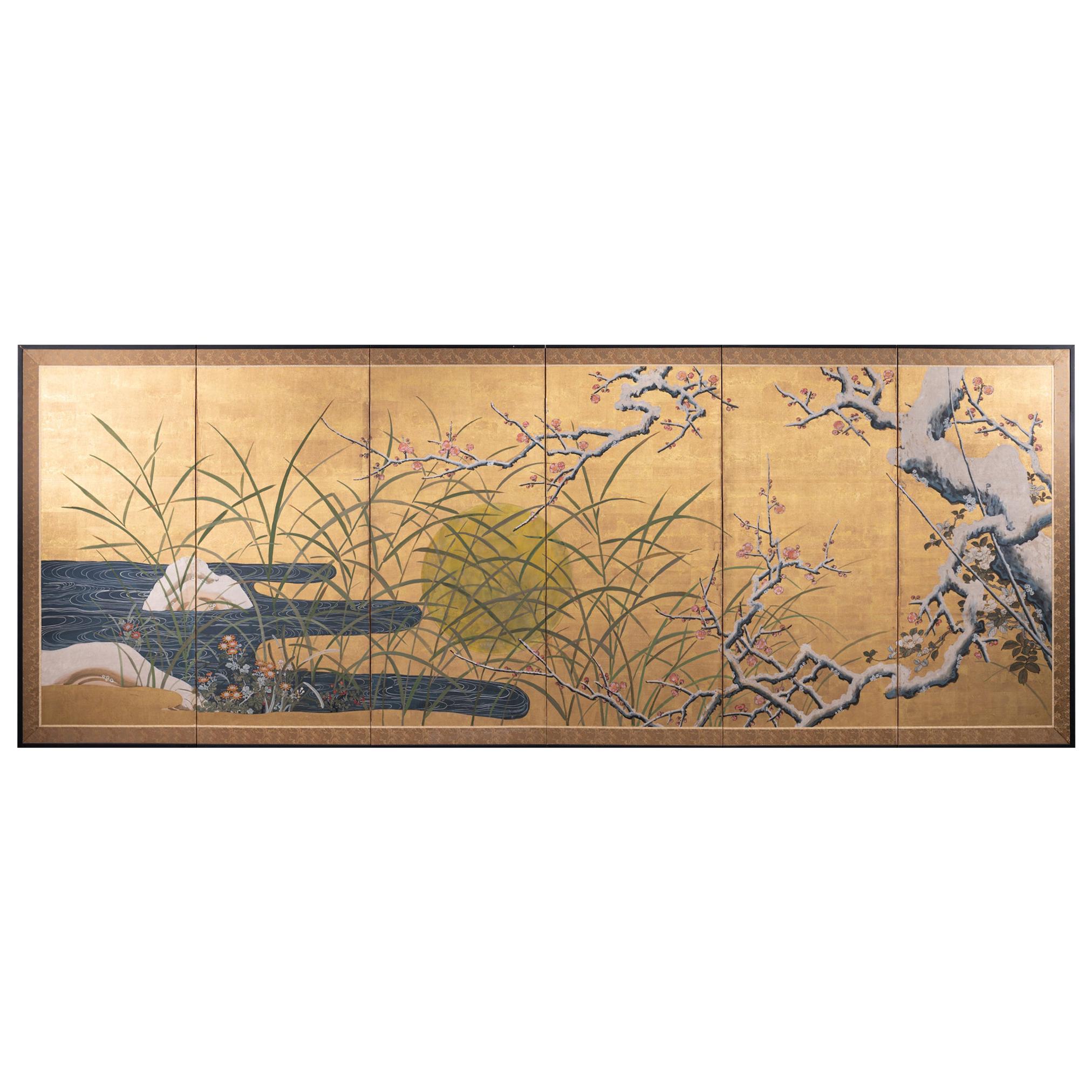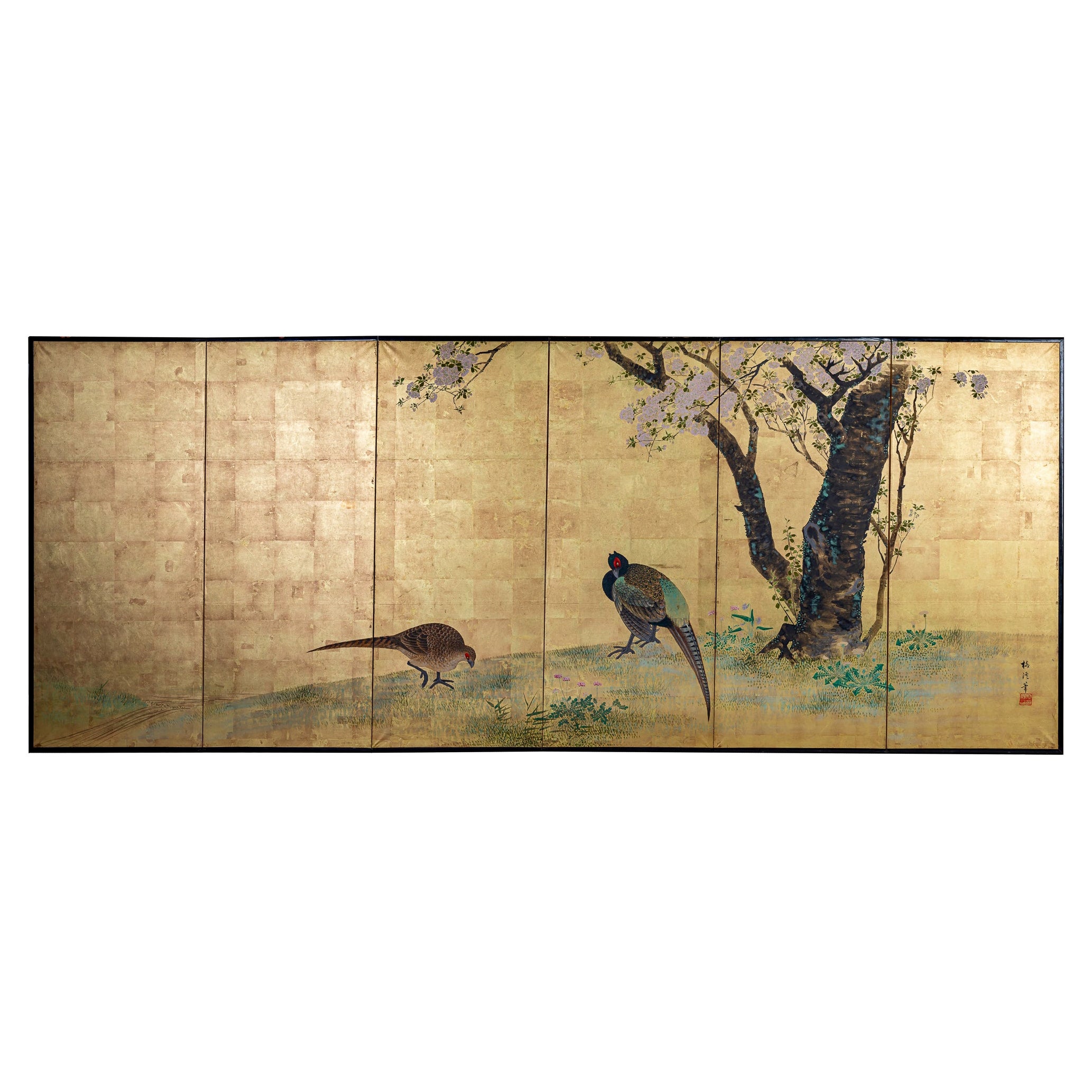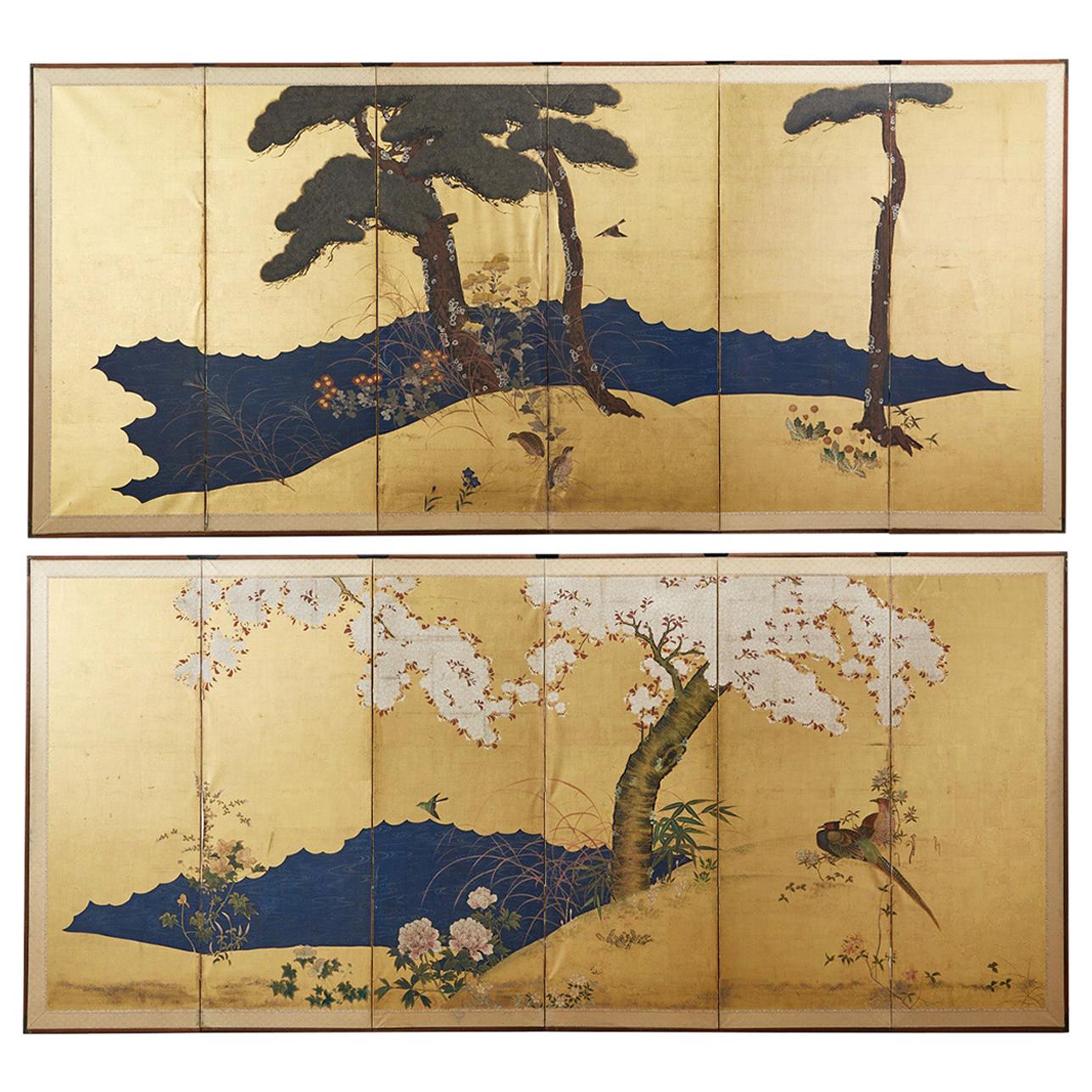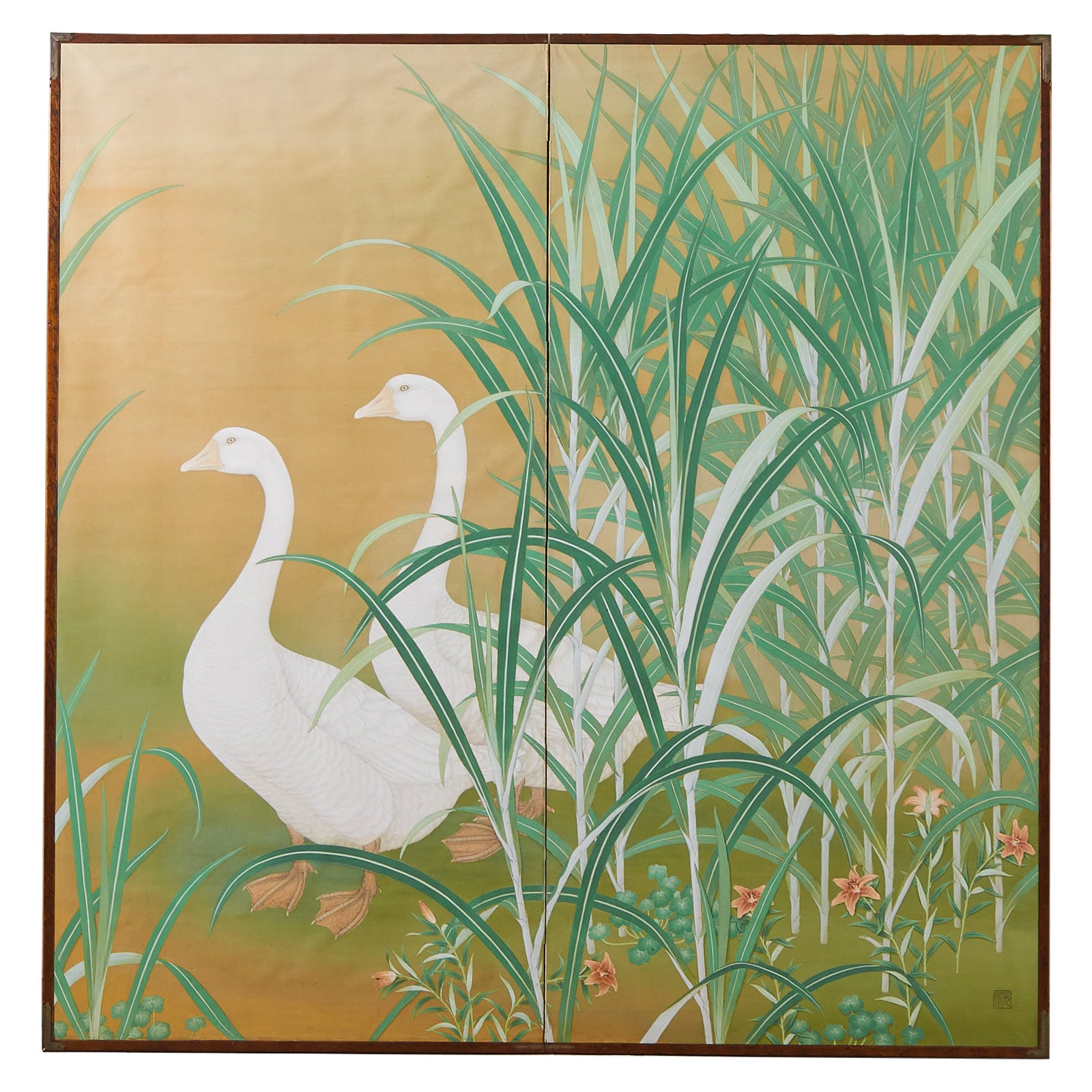Items Similar to Japanese Six-Panel Meiji Screen Flowering Peonies and Butterflies
Want more images or videos?
Request additional images or videos from the seller
1 of 20
Japanese Six-Panel Meiji Screen Flowering Peonies and Butterflies
About the Item
Stunning Japanese Meiji period six-panel large screen. Featuring blooms of spring flowering white, pink, and red peonies with butterflies over a gilt background. Made in the Nihonga school style with ink and color pigments on gilt. Two artists seals on the bottom left side of the screen. Set in a wood frame with a natural finish. From an estate in Beverly Hills, CA.
- Dimensions:Height: 67 in (170.18 cm)Width: 149 in (378.46 cm)Depth: 0.75 in (1.91 cm)
- Style:Meiji (Of the Period)
- Materials and Techniques:
- Place of Origin:
- Period:
- Date of Manufacture:Late 19th-Early 20th Century
- Condition:Wear consistent with age and use. Minor losses. Beautifully crafted with age appropriate wear at joints as seen in photos. Losses on back side of screen.
- Seller Location:Rio Vista, CA
- Reference Number:1stDibs: LU1555217783022
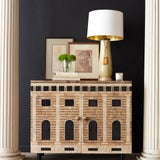
About the Seller
5.0
Erin Lane Estate is based in the San Francisco Bay Area, and its team of furniture restorers, art curators, professional appraisers and Asia specialists sources prime vintage and antique furniture from the finest estates in Northern and Southern California. Erin Lane Estate specializes in Hollywood Regency, McGuire, Chinese and Japanese pieces.
Diamond Seller
These expertly vetted sellers are 1stDibs' most experienced sellers and are rated highest by our customers.
Established in 2000
1stDibs seller since 2015
2,633 sales on 1stDibs
Typical response time: 1 hour
- ShippingRetrieving quote...Ships From: Rio Vista, CA
- Return PolicyA return for this item may be initiated within 1 day of delivery.
More From This SellerView All
- Pair of Japanese Meiji Six Panel Screens of Seasonal LandscapesLocated in Rio Vista, CAFascinating pair of large Japanese Meiji period six-panel screens of seasonal landscapes with flowers and birds. The first screen depicts a pair of pheasants in a spring landscape with a white flowering cherry tree, peonies, and rose of Sharon with brush clover. The second screen depicts a pair of quail in an autumn landscape with flowering autumn plants and grasses including chrysanthemums, bellflowers, and ominaeshi. The umbrella pines appear to be in the manner of Kano Tanyu...Category
Antique 19th Century Japanese Meiji Paintings and Screens
MaterialsBrass, Gold Leaf
- Japanese Meiji Two Panel Screen Geese and ReedsLocated in Rio Vista, CAFantastic Japanese late Meiji period two-panel byobu screen by Hashimoto Koshu. The large screen features two white geese amid brightly colored reeds. The symbolism of geese and reeds was introduced to Japan from China in the 13th century. This was a popular subject for Japanese zen artists of the period. Beautifully crafted with exceptional brush strokes and details. Made with natural pigments in dramatic vivid colors of white, pink, and mint green on a silk background of gilt. Circa 1900 with artist seal on bottom right corner. Koshu studied Western art under...Category
20th Century Japanese Meiji Paintings and Screens
MaterialsSilk, Wood, Paper
- Japanese Meiji Two Panel Screen Song Birds in SakuraLocated in Rio Vista, CAExceptional Japanese Meiji period two-panel screen, circa 1900. Featuring songbirds amid sakura cherry trees and flowering peony. Made in the Nihonga School style on handcrafted mulb...Category
20th Century Japanese Meiji Paintings and Screens
MaterialsBrass
- Japanese Meiji Four Panel Screen Flowering Grasses of AutumnLocated in Rio Vista, CARemarkable late 19th century Meiji period Japanese four panel byobu screen featuring the flowering grasses of autumn: Chinese bellflower, bush clover, and ominaeshi (Patrinia Scabios...Category
Antique 19th Century Japanese Meiji Paintings and Screens
MaterialsSilver Leaf
- Japanese Six Panel Kano School Winter Landscape ScreenLocated in Rio Vista, CALarge Japanese Meiji period six-panel screen depicting a winter landscape with a Chinese sage visiting friends in a country villa. Ink and vivid color pigments on mulberry paper mounted to a gilt background. Painted in the 19th century Kano school...Category
Antique 19th Century Japanese Meiji Paintings and Screens
MaterialsMetal
- Japanese Edo Six Panel Screen Yoshitsune and BenkeiLocated in Rio Vista, CASpectacular 19th century Japanese late Edo period six-panel byobu screen depicting Yoshitsune and Benkei, two heroes of Japanese folklore. Crafted in ink and natural color pigments on mulberry paper with thick gold leaf borders on each panel. The character Yoshitsune is seated under a blossoming cherry tree in full armor holding a fan. The warrior priest or monk Benkei is depicted kneeling on a leopard skin...Category
Antique 19th Century Japanese Edo Paintings and Screens
MaterialsBrass, Gold Leaf
You May Also Like
- Japanese Six-Panel Screen, Winter Landscape with Flowering PlumLocated in Hudson, NYJapanese six-panel screen: Winter landscape with flowering plum, Meiji period (1868-1912) painting of a full moon with wild grasses between river's edge and a snow covered plum tree ...Category
Early 20th Century Japanese Meiji Paintings and Screens
MaterialsGold Leaf
- Japanese Six Panel Screen: Pheasants Beneath Flowering CherryLocated in Hudson, NYMineral pigments on gold leaf. Signature and seal read: Baikei Hitsu.Category
Antique Late 19th Century Japanese Paintings and Screens
MaterialsGold Leaf
- Japanese Six-Panel Screen "Wild Grasses and Peonies by Rivers Edge"Located in Hudson, NYJapanese Six Panel Screen: Wild Grasses and Peonies by Rivers Edge. Early Meiji period (1868 - 1912) painting of a grassy knoll next to a running brook or river. A soft breeze is m...Category
Antique 1880s Japanese Meiji Paintings and Screens
MaterialsGold Leaf
- Japanese Two Panel Screen: Flowering Vines and WisteriaLocated in Hudson, NYWisteria represents sentiments of love and longevity as vibrant floral colors dance dramatically amongst the two panels. Mineral pigments on Mulberry paper with a natural wood trim....Category
Early 20th Century Japanese Paintings and Screens
MaterialsWood, Paper
- Japanese Two-Panel Screen Peony and CherryLocated in Hudson, NYJapanese two-panel screen: Peony and Cherry, Edo period (circa 1800) painting, formerly fusuma (Japanese sliding doors), executed in the Kano school style, featuring a cherry tree in...Category
Antique Early 1800s Japanese Edo Paintings and Screens
MaterialsGold Leaf
- Japanese Six Panel Screen, Peonies and Young Growth on Gold SilkLocated in Hudson, NYRimpa floral scene. Pigment on gilded silk, signature and seal read: Hattori Shunyo. Bold colors and strong design elements combined with the trademark tarashikomi (diluted elements created when water is applied to the surface before or after pigments causing them to diffuse) exhibit the artists deep devotion to this important Japanese painting tradition. Notes about artist: Hattori Shunyo (b. 1883) was an artist from Kyoto who graduated the (now) Kyoto Municipal University of Art and fell under the circle of Yamamoto Shunkyo...Category
Early 20th Century Japanese Paintings and Screens
MaterialsBrocade, Silk
Recently Viewed
View AllMore Ways To Browse
Panel Large
Six Panel
Painted Panel Screen
Gilt Wood Panel
Natural Wood Japanese
Japanese Painted Screen
Japanese Paint Screen
Asian Panel And Screen Paintings
Screen Panels 19th
Ebonized Panel
20th Japanese Screen
20th Century Japanese Screen
20th Century Japanese Screens
Japanese Screen Framed
Large Screen Panel
Gilt Screen
Japanese Wood Screen
Japanese Hand Painted Panel
